Diffuse Pollution and Ecological Risk Assessment in Ludaš Lake Special Nature Reserve and Palić Nature Park (Pannonian Basin)
Abstract
:1. Introduction
- -
- facilitating the restoration and connectivity of forest-steppe habitats, giving information about hotspots, the locations with the highest loads of metals and nutrients;
- -
- enforcing DWPA consciousness with the application of mitigation measures on agricultura; plots with the highest levels of pollution that require increased awareness, penalties, and incentives.
2. Materials and Methods
2.1. Study Area
2.2. Methodology
2.2.1. Sampling and Analysis
2.2.2. Ecological Risk Assessment
2.2.3. Geospatial and Statistical Analysis
3. Results
3.1. Physical and Chemical Soil Properties
3.2. Nutrient Concentration in Soil (N, P2O5, K2O)
3.3. Concentration of Heavy Metals in Soil
3.4. Pollution Indices
4. Discussion
5. Conclusions
Author Contributions
Funding
Institutional Review Board Statement
Informed Consent Statement
Data Availability Statement
Acknowledgments
Conflicts of Interest
References
- Okumah, M.; Chapman, P.J.; Martin-Ortega, J.; Novo, P. Mitigating agricultural diffuse pollution: Uncovering the evidence base of the awareness-behaviour-water quality pathway. Water 2018, 11, 29. [Google Scholar] [CrossRef] [Green Version]
- Cao, X.; Song, C.; Xiao, J.; Zhou, Y. The optimalwidth and mechanism of riparian buffers for storm water nutrient removal in the Chinese eutrophic Lake Chaohu watershed. Water 2018, 10, 1489. [Google Scholar] [CrossRef]
- World Wild Fund for Nature (WWF). Living Planet Report 2016: Risk and Resilience in a New Era; World Wild Fund for Nature (WWF): Grand, Switzerland, 2016; ISBN 9782940529407. [Google Scholar]
- Harrison, S.; McAree, C.; Mulville, W.; Sullivan, T. The problem of agricultural ‘diffuse’ pollution: Getting to the point. Sci. Total Environ. 2019, 677, 700–717. [Google Scholar] [CrossRef]
- Turunen, J.; Markkula, J.; Rajakallio, M.; Aroviita, J. Riparian forests mitigate harmful ecological effects of agricultural diffuse pollution in medium-sized streams. Sci. Total Environ. 2019, 649, 495–503. [Google Scholar] [CrossRef]
- Lange, U.; Döhler, H.; Eurich-Menden, B.; Gömann, H.; Jäger, P.; Kreins, P.; Möller, C.; Prigge, A.; Ristenpart, E.; Schultheiß, U. Evaluation of Policy Measures and Methods to Reduce Diffuse Water Pollution; Federal Environmental Agency (Umweltbundesamt) UBA: Dessau, Germany, 2006; 168p.
- Diffuse Pollution, Degraded Waters: Emerging policy solutions. Water Intell. Online 2017, 16, 9781780408798. [CrossRef]
- Mazurek, R.; Kowalska, J.; Gąsiorek, M.; Zadrożny, P.; Józefowska, A.; Zaleski, T.; Kępka, W.; Tymczuk, M.; Orłowska, K. Assessment of heavy metals contamination in surface layers of Roztocze National Park forest soils (SE Poland) by indices of pollution. Chemosphere 2017, 168, 839–850. [Google Scholar] [CrossRef] [PubMed]
- Bartkowiak, A.; Lemanowicz, J.; Hulisz, P. Ecological risk assessment of heavy metals in salt-affected soils in the Natura 2000 area (Ciechocinek, north-central Poland). Environ. Sci. Pollut. Res. 2017, 24, 27175–27187. [Google Scholar] [CrossRef] [PubMed] [Green Version]
- Barbieri, M.; Sappa, G.; Nigro, A. Soil pollution: Anthropogenic versus geogenic contributions over large areas of the Lazio region. J. Geochemical Explor. 2018, 195, 78–86. [Google Scholar] [CrossRef]
- Jia, Z.; Li, S.; Wang, L. Assessment of soil heavy metals for eco-environment and human health in a rapidly urbanization area of the upper Yangtze Basin. Sci. Rep. 2018, 8, 3256. [Google Scholar] [CrossRef] [Green Version]
- Yan, X.; Liu, M.; Zhong, J.; Guo, J.; Wu, W. How human activities affect heavy metal contamination of soil and sediment in a long-term reclaimed area of the Liaohe River Delta, North China. Sustainability 2018, 10, 338. [Google Scholar] [CrossRef] [Green Version]
- Zhen, Z.; Wang, S.; Luo, S.; Ren, L.; Liang, Y.; Yang, R.; Li, Y.; Zhang, Y.; Deng, S.; Zou, L.; et al. Significant Impacts of Both Total Amount and Availability of Heavy Metals on the Functions and Assembly of Soil Microbial Communities in Different Land Use Patterns. Front. Microbiol. 2019, 10, 2293. [Google Scholar] [CrossRef]
- Chibuike, G.U.; Obiora, S.C. Heavy metal polluted soils: Effect on plants and bioremediation methods. Appl. Environ. Soil Sci. 2014, 2014, 752708. [Google Scholar] [CrossRef] [Green Version]
- Dharani, N.; Onyari, J.M.; Maina, D.M.; Mavuti, K.M. The distribution of Cu and Pb levels in soils and Acacia xanthophloea Benth. from Lake Nakuru National Park Kenya. Bull. Environ. Contam. Toxicol. 2007, 79, 172–177. [Google Scholar] [CrossRef]
- Mikhailenko, A.V.; Ruban, D.A.; Ermolaev, V.A.; van Loon, A.J. Cadmium pollution in the tourism environment: A literature review. Geosciences 2020, 10, 242. [Google Scholar] [CrossRef]
- Khalid, N.; Hussain, M.; Young, H.S.; Boyce, B.; Aqeel, M.; Noman, A. Effects of road proximity on heavy metal concentrations in soils and common roadside plants in Southern California. Environ. Sci. Pollut. Res. 2018, 25, 35257–35265. [Google Scholar] [CrossRef] [PubMed]
- Hashmi, M.Z.; Yu, C.; Shen, H.; Duan, D.; Shen, C.; Lou, L.; Chen, Y. Risk assessment of heavy metals pollution in agricultural soils of siling reservoir watershed in Zhejiang province, China. Biomed. Res. Int. 2013, 2013. [Google Scholar] [CrossRef]
- Wei, B.; Yu, J.; Cao, Z.; Meng, M.; Yang, L.; Chen, Q. The availability and accumulation of heavy metals in greenhouse soils associated with intensive fertilizer application. Int. J. Environ. Res. Public Health 2020, 17, 5359. [Google Scholar] [CrossRef] [PubMed]
- Ayari, J.; Barbieri, M.; Agnan, Y.; Sellami, A.; Braham, A.; Dhaha, F.; Charef, A. Trace element contamination in the mine-affected stream sediments of Oued Rarai in north-western Tunisia: A river basin scale assessment. Environ. Geochem. Health 2021, 43, 4027–4042. [Google Scholar] [CrossRef]
- Navarro-Pedreño, J.; Almendro-Candel, M.B.; Lucas, I.G.; Vidal, M.M.J.; Borras, J.B.; Zorpas, A.A. Trace metal content and availability of essential metals in agricultural soils of Alicante (Spain). Sustainability 2018, 10, 4534. [Google Scholar] [CrossRef] [Green Version]
- Rudić, Ž. Factors of Water Quality Degradation in Shallow Pannonian Lakes and Their Contribution to Ecological Risk. Ph.D. Thesis, Faculty of Agriculture, University of Belgrade, Beograd, Serbia, 2 September 2015. (In Serbian). [Google Scholar]
- Böhm, E.; Hillenbrand, T.; Walz, R.; Borchardt, D.; Henke, S. Maßnahmenplan Nachhaltige Wasserwirtschaft. Handlungsschwerpunkte für Einen Zukunftsorientierten Umgang mit Wasser in Deutschland: Forschungsbericht zum Vorhaben 297 27 707; UBA-Text 25/99; Umweltbundesamt (UBA): Berlin, Germany, 1999.
- Statistical Office of the Republic of Serbia. Agriculture Census. Available online: https://www.stat.gov.rs/en-US (accessed on 30 September 2021).
- Public Company Palić—Ludaš. Management Plan of Nature Park “Palić” for the Period 2014–2023; Institute for Nature Conservation of Serbia: Belgrade, Serbia, 2014; 99p. (In Serbian) [Google Scholar]
- Raicevic, V.; Bozic, M.; Rudic, Z.; Lalevic, B.; Kikovic, D. The evolution of the eutrophication of the Palić lake (Serbia). Afr. J. Biotechnol. 2011, 10, 1736–1744. [Google Scholar] [CrossRef]
- Europian Commisssion. Available online: https://ec.europa.eu/environment/nature/natura2000/faq_en.htm (accessed on 30 September 2021).
- Official Gazette of Republic of Serbia 95/2018-267. Law on Nature Protection; Official Gazette: Belgrade, Serbia, 2018. (In Serbian) [Google Scholar]
- EA 2021 River Basin Management Plans, Natura 2000 Protected Areas; Environment Agency: Bristol, UK, 2019; pp. 1–27.
- Seleši, Đ. The Extinction and Renovation of Lake Palic; Fond za Sanaciju Jezera Palić: Subotica, Yugoslavia, 1973. (In Serbian) [Google Scholar]
- Biodiversity and Water Protection Lake Palic and Lake Ludas. Available online: https://www.zastitapalicludas.rs/en/project/ (accessed on 30 September 2021).
- Huang, K.; Luo, X.; Zheng, Z. Application of a combined approach including contamination indexes, geographic information system and multivariate statistical models in levels, distribution and sources study of metals in soils in Northern China. PLoS ONE 2018, 13, e0190906. [Google Scholar] [CrossRef] [PubMed] [Green Version]
- Charzyński, P.; Plak, A.; Hanaka, A. Influence of the soil sealing on the geoaccumulation index of heavy metals and various pollution factors. Environ. Sci. Pollut. Res. 2017, 24, 4801–4811. [Google Scholar] [CrossRef] [PubMed] [Green Version]
- Okedeyi, O.O.; Dube, S.; Awofolu, O.R.; Nindi, M.M. Assessing the enrichment of heavy metals in surface soil and plant (Digitaria eriantha) around coal-fired power plants in South Africa. Environ. Sci. Pollut. Res. 2014, 21, 4686–4696. [Google Scholar] [CrossRef] [PubMed]
- Miljković, P. The Influence of Land Cover on the Quality of Suspended Sediment in the Rasina River Watershed. Ph.D. Thesis, Faculty of Forestry, University of Belgrade, Beograd, Serbia, 30 October 2020. (In Serbian). [Google Scholar]
- El-Amier, Y.A.; Bonanomi, G.; Al-Rowaily, S.L.; Abd-Elgawad, A.M. Ecological risk assessment of heavy metals along three main drains in nile delta and potential phytoremediation by macrophyte plants. Plants 2020, 9, 910. [Google Scholar] [CrossRef]
- Adimalla, N.; Wang, H. Distribution, contamination, and health risk assessment of heavy metals in surface soils from northern Telangana, India. Arab. J. Geosci. 2018, 11, 684. [Google Scholar] [CrossRef]
- Marković, M.; Zuliani, T.; Simić, S.B.; Mataruga, Z.; Kostić, O.; Jarić, S.; Vidmar, J.; Milačič, R.; Ščančar, J.; Mitrović, M.; et al. Potentially toxic elements in the riparian soils of the Sava River. J. Soils Sediments 2018, 18, 3404–3414. [Google Scholar] [CrossRef] [Green Version]
- Santos-Francés, F.; Martínez-Graña, A.; Rojo, P.A.; Sánchez, A.G. Geochemical background and baseline values determination and spatial distribution of heavy metal pollution in soils of the andes mountain range (Cajamarca-Huancavelica, Peru). Int. J. Environ. Res. Public Health 2017, 14, 859. [Google Scholar] [CrossRef] [Green Version]
- Kowalska, J.B.; Mazurek, R.; Gąsiorek, M.; Zaleski, T. Pollution indices as useful tools for the comprehensive evaluation of the degree of soil contamination–A review. Environ. Geochem. Health 2018, 40, 2395–2420. [Google Scholar] [CrossRef] [Green Version]
- WRB-IUSS. World Reference Base for Soil Resources 2014. World Soil Resources Reports 106; Food and Agriculture Organization of the United Nations: Rome, Italy, 2014; ISBN 9789251083697. [Google Scholar]
- Janković, M. Study on Geotechnical Conditions of Construction Bicycle Trails around Palić Lake; Vuma Studio: Kraljevo, Serbia, 2019. (phase: Part of Project documentation; project “Biodiversity and Water Protection Lake Palić and Lake Ludaš”) (In Serbian) [Google Scholar]
- Institute for Nature Conservation of Serbia. Special Nature Reserve “Ludaš Lake” Expert—Documentary Basis for Revision; Institute for Nature Conservation of Serbia: Belgrade, Serbia, 2004; 127p. (In Serbian) [Google Scholar]
- Institute for Nature Conservation of Vojvodina Province. Nature Park “Palić”, Proposal for Protection as a Protected Area of III Category—Protection Study; Institute for Nature Conservation of Vojvodina Province: Novi Sad, Serbia, 2011. (In Serbian) [Google Scholar]
- Štadler, A. Histroy of Palić 1462-1958; Public Company “Palić—Ludaš”: Subotica, Serbia, 1998; 151p, ISBN 86-83201-01-5. (In Serbian) [Google Scholar]
- Gržetić, I.; Čamprag, N. The evolution of the trophic state of the Palić Lake (Serbia). J. Serbian Chem. Soc. 2010, 75, 717–732. [Google Scholar] [CrossRef]
- Horvat, M.; Horvat, Z. Implementation of a monitoring approach: The Palic-Ludas lake system in the Republic of Serbia. Environ. Monit. Assess. 2020, 192, 150. [Google Scholar] [CrossRef]
- Final Report of Assessment of the Cause of the Fish Kill in Lake Palic and Lake Ludas. Available online: https://www.zastitapalicludas.rs/wp-content/uploads/2021/05/Fish-kill-report-short-ENG.pdf (accessed on 1 October 2021).
- Topalović, S. The existing quality of environment and the possibilities of the development of viable tourism in the specific natural reservation of the lake Ludaš. Bull. Serb. Geogr. Soc. 2010, 90, 189–207. [Google Scholar] [CrossRef]
- Institute of Public Health Subotica Center for Hygiene and Human Ecology. Annual Report of Water Quality Monitoring of Lakes Palic, Ludas and Palić-Ludaš Canal in 2019. Available online: http://www.subotica.rs/documents/pages/8242_1.pdf (accessed on 1 October 2021). (In Serbian).
- Yugoslav Society for Soil Research. Study Methods for Soil Physical Properties; Yugoslav Society for Soil Research: Novi Sad, Serbia, 1997. (In Serbian) [Google Scholar]
- ISO 10390:2007. Soil Quality—Determination of pH; International Organization for Standardization: Geneva, Switzerland, 2007. [Google Scholar]
- ISO 11265:1994. Soil Quality—Determination of the Specific Electrical Condutivity; International Organization for Standardization: Geneva, Switzerland, 1994. [Google Scholar]
- ISO 10694:2005. Soil Quality—Determination of Organic and Total Carbon after Dry Combustion (Elementary Analysis); International Organization for Standardization: Geneva, Switzerland, 2005. [Google Scholar]
- ISO 10693:2005. Soil Quality—Determination of Carbonate Content—Volumetric Method); International Organization for Standardization: Geneva, Switzerland, 2005. [Google Scholar]
- ISO 11263:2016. Soil quality—Determination of Phosphorus—Spectrometric Determination of Phosphorus Soluble in Sodium Hydrogen Carbonate Solution); International Organization for Standardization: Geneva, Switzerland, 2016. [Google Scholar]
- ISO 11261:2005. Soil Quality—Determination of Total Nitrogen—Modified Kjeldahl Method); International Organization for Standardization: Geneva, Switzerland, 2005. [Google Scholar]
- Knežević, M.; Košanin, O. Workbook of Pedology; Faculty of Forestry, University of Belgrade: Belgrade, Serbia, 2007; ISBN 978-86-7299-143-7. (In Serbian) [Google Scholar]
- Yugoslav Society for Soil Science. Chemical Methods of Soil Surveying, Book 1; Yugoslav Society for Soil Research: Belgrade, Serbia, 1966. (In Serbian) [Google Scholar]
- ISO 11466:1955. Soil Quality—Extraction of Trace Elements Soluble in Aqua Regia); International Organization for Standardization: Geneva, Switzerland, 1995. [Google Scholar]
- ISO 11047:2004. Soil Quality—Determination of Cadmium, Chromium, Cobalt, Copper, Lead, Manganese, Nickel and Zinc—Flame and Electrothermal Atomic Absorption Spectrometric Methods); International Organization for Standardization: Geneva, Switzerland, 2004. [Google Scholar]
- Ninkov, J.; Marković, S.; Banjac, D.; Vasin, J.; Milić, S.; Banjac, B.; Mihailović, A. Mercury content in agricultural soils (Vojvodina Province, Serbia). Environ. Sci. Pollut. Res. 2017, 24, 10966–10975. [Google Scholar] [CrossRef]
- Weissmannová, H.D.; Mihočová, S.; Chovanec, P.; Pavlovský, J. Potential ecological risk and human health risk assessment of heavy metal pollution in industrial affected soils by coal mining and metallurgy in Ostrava, Czech Republic. Int. J. Environ. Res. Public Health 2019, 16, 4495. [Google Scholar] [CrossRef] [PubMed] [Green Version]
- Barbieri, M. The Importance of Enrichment Factor (EF) and Geoaccumulation Index (Igeo) to Evaluate the Soil Contamination. J. Geol. Geophys. 2016, 5, 237. [Google Scholar] [CrossRef]
- Bu, J.; Sun, Z.; Zhou, A.; Xu, Y.; Ma, R.; Wei, W.; Liu, M. Heavy metals in surface soils in the upper reaches of the Heihe River, northeastern Tibetan Plateau, China. Int. J. Environ. Res. Public Health 2016, 13, 247. [Google Scholar] [CrossRef] [PubMed] [Green Version]
- Müller, G. Index of geoaccumulation in sediments of the Rhine River. GeoJournal 1969, 2, 108–118. [Google Scholar]
- Håkanson, L. An ecological risk index for aquatic pollution controla sedimentological approach. Water Res. 1980, 14, 975–1001. [Google Scholar] [CrossRef]
- Nemerow, N.L. Stream, Lake, Estuary, and Ocean Pollution; Van Nostrand Reinhold Publishing Co.: New York, NY, USA, 1985; ISBN 978-0442267209. [Google Scholar]
- Sutherland, R.A.; Tolosa, C.A.; Tack, F.M.G.; Verloo, M.G. Characterization of Selected Element Concentrations and Enrichment Ratiosin Background and Anthropogenically Impacted Roadside Areas. Arch. Environ. Contam. Toxicol. 2000, 38, 428–438. [Google Scholar] [CrossRef]
- Zhang, J.; Liu, C.L. Riverine composition and estuarine geochemistry of particulate metals in China—Weathering features, anthropogenic impact and chemical fluxes. Estuar. Coast. Shelf Sci. 2002, 54, 1051–1070. [Google Scholar] [CrossRef]
- Luo, W.; Lu, Y.; Giesy, J.P.; Wang, T.; Shi, Y.; Wang, G.; Xing, Y. Effects of land use on concentrations of metals in surface soils and ecological risk around Guanting Reservoir, China. Environ. Geochem. Health 2007, 29, 459–471. [Google Scholar] [CrossRef]
- Official Gazette of Republic of Serbia 64/2019. Regulation on Limit Values of Polluting, Harmful and Dangerous Substances in the Soil; Official Gazette: Belgrade, Serbia, 2019. (In Serbian) [Google Scholar]
- Lech, M.; Fronczyk, J.; Radziemska, M.; Sieczka, A.; Garbulewski, K.; Koda, E.; Lechowicz, Z. Monitoring of total dissolved solids on agricultural lands using electrical conductivity measurements. Appl. Ecol. Environ. Res. 2016, 14, 285–295. [Google Scholar] [CrossRef]
- Manojlović, M. Yield and Soil Load in the Border Area; Faculty of Agriculture, University of Novi Sad: Novi Sad, Serbia, 2014; ISBN 978-86-7520-290-5. (In Serbian) [Google Scholar]
- Beloica, J. Air Pollution and Forest Ecosystem; Faculty of Forestry, University of Belgrade: Belgrade, Serbia, 2020; ISBN 978-86-7299-314-1. (In Serbian) [Google Scholar]
- Nunes, J.R.; Ramos-Miras, J.; Lopez-Piñeiro, A.; Loures, L.; Gil, C.; Coelho, J.; Loures, A. Concentrations of available heavy metals in Mediterranean agricultural soils and their relation with some soil selected properties: A case study in typical Mediterranean soils. Sustainability 2014, 6, 9124–9138. [Google Scholar] [CrossRef] [Green Version]
- Kabata-Pendias, A. Trace Elements in Soils and Plants, 4th ed.; CRC Press: Boca Raton, FL, USA, 2010; ISBN 9781420093704. [Google Scholar]
- Kastori, R. Heavy Metals and Pesticides in Soil, Heavy Metals and Pesticide in the Soil of the Vojvodina Province; Faculty of Agriculture, University of Novi Sad: Novi Sad, Serbia, 1993; ISBN 86-80417-01-7. (In Serbian) [Google Scholar]
- Alloway, B.J. Heavy Metals in Soils Trace—Metals and Metalloids in Soils and their Bioavailability, 3rd ed.; Springer: Berlin/Heidelberg, Germany, 2013; ISBN 978-94-007-4469-1. [Google Scholar]
- Singh, B. Are Nitrogen Fertilizers Deleterious to Soil Health? Agronomy 2018, 8, 48. [Google Scholar] [CrossRef] [Green Version]
- Zhang, Y.; Zhang, H.; Zhang, Z.; Liu, C.; Sun, C.; Zhang, W.; Marhaba, T. PH Effect on Heavy Metal Release from a Polluted Sediment. J. Chem. 2018, 2018, 7597640. [Google Scholar] [CrossRef]
- Roberts, T.L. Cadmium and Phosphorous Fertilizers: The Issues and the Science. Procedia Eng. 2014, 83, 52–59. [Google Scholar] [CrossRef] [Green Version]
- Haider, F.U.; Liqun, C.; Coulter, J.A.; Cheema, S.A.; Wu, J.; Zhang, R.; Wenjun, M.; Farooq, M. Cadmium toxicity in plants: Impacts and remediation strategies. Ecotoxicol. Environ. Saf. 2021, 211, 111887. [Google Scholar] [CrossRef]
- Huang, L.; Rad, S.; Xu, L.; Gui, L.; Song, X.; Li, Y.; Wu, Z.; Chen, Z. Heavy metals distribution, sources, and ecological risk assessment in Huixian Wetland, South China. Water 2020, 12, 431. [Google Scholar] [CrossRef] [Green Version]
- U.S. Enviromental Protection Agency. Protecting Water Quality from Agricultural Runoff; U.S. Enviromental Protection Agency: Washington, DC, USA, 2005; 2p.
- Lausche, B. Guidelines for Protected Areas Legislation; International Union for Conservation of Nature and Natural Resources IUCN: Gland, Switzerland, 2011; ISBN 9782831712451. [Google Scholar]
- He, Z.L.; Yang, X.E.; Stoffella, P.J. Trace elements in agroecosystems and impacts on the environment. J. Trace Elem. Med. Biol. 2005, 19, 125–140. [Google Scholar] [CrossRef] [PubMed]
- Gilbert, N. European Union debates controversal plans to limit cadmium in fertilizer, American Association for the Advancement of Science (AAAS). Science 2018, 10. [Google Scholar] [CrossRef]
- EU Council Directive 834/2007 on organic production and labelling of organic products. Off. J. Eur. Union 2007, 2007, 1–23.
- Food and Agriculture Organization of the United Nations. Available online: http://www.fao.org/organicag/oa-faq/oa-faq6/en/ (accessed on 1 October 2021).
- Grandi, C.; Triantafyllidis, A. Organic Agriculture in Protected Areas. The Italian Experience; Food and Agriculture Organization of the United Nations: Rome, Italy, 2010; 29p. [Google Scholar]
- Pfiffnee, L.; Balmer, O. Organic Agriculture and Biodiversity; Fact Sheet; Research Institute of Organic Agriculture (FiBL): Frankfurt am Main, Germany, 2011; ISBN 978-3-03736-195-5. [Google Scholar]
- Lawniczak, A.E.; Zbierska, J.; Nowak, B.; Achtenberg, K.; Grześkowiak, A.; Kanas, K. Impact of agriculture and land use on nitrate contamination in groundwater and running waters in central-west Poland. Environ. Monit. Assess. 2016, 188, 172. [Google Scholar] [CrossRef] [PubMed] [Green Version]
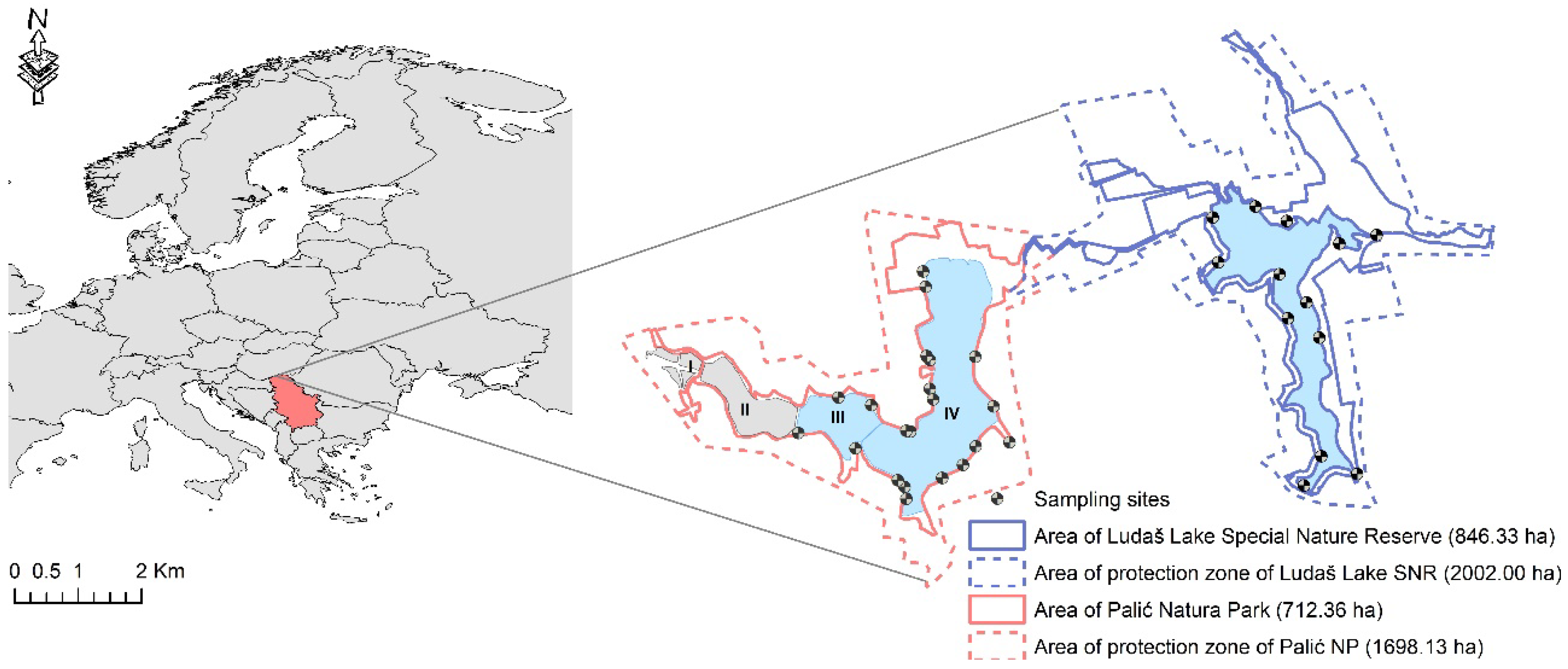
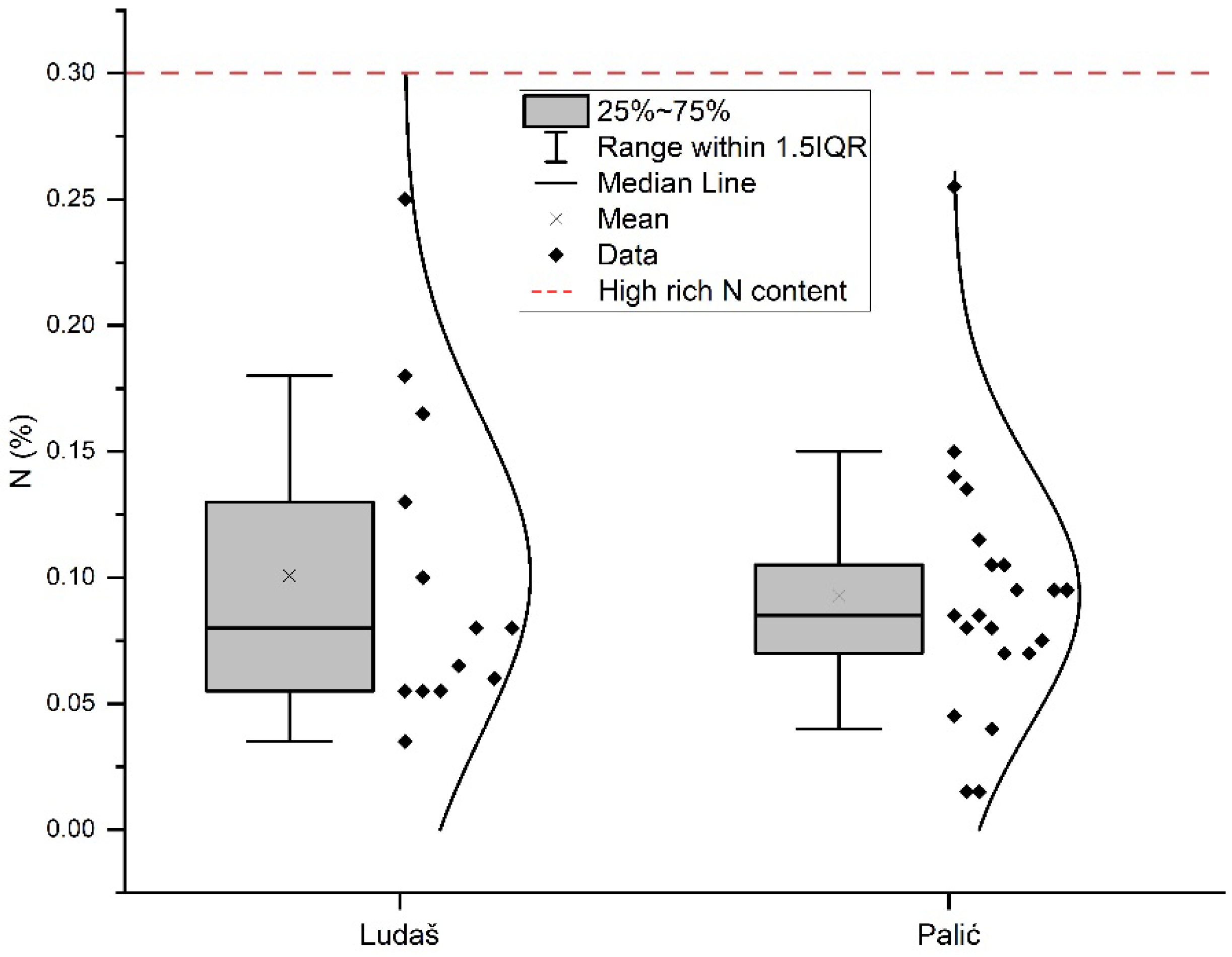

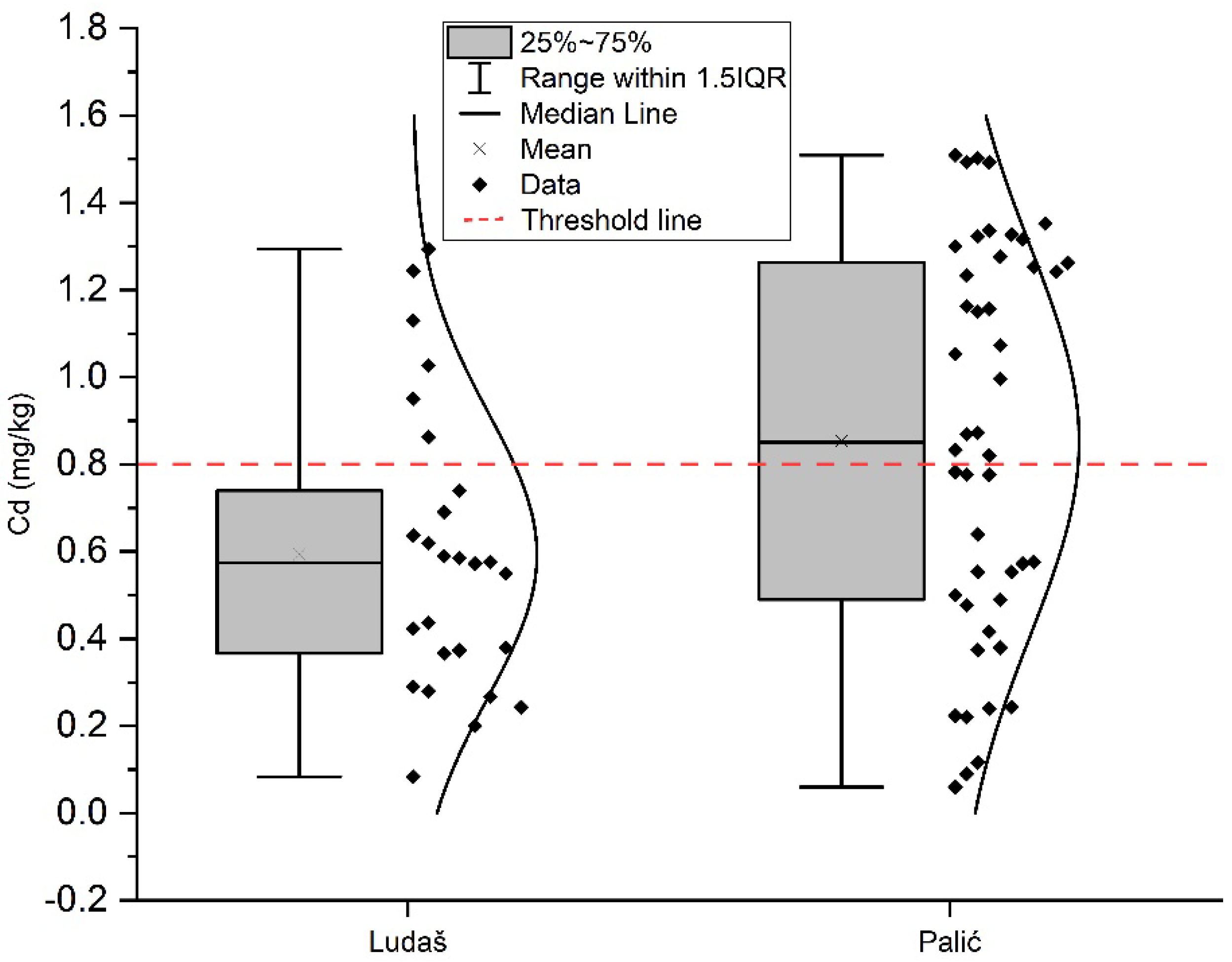
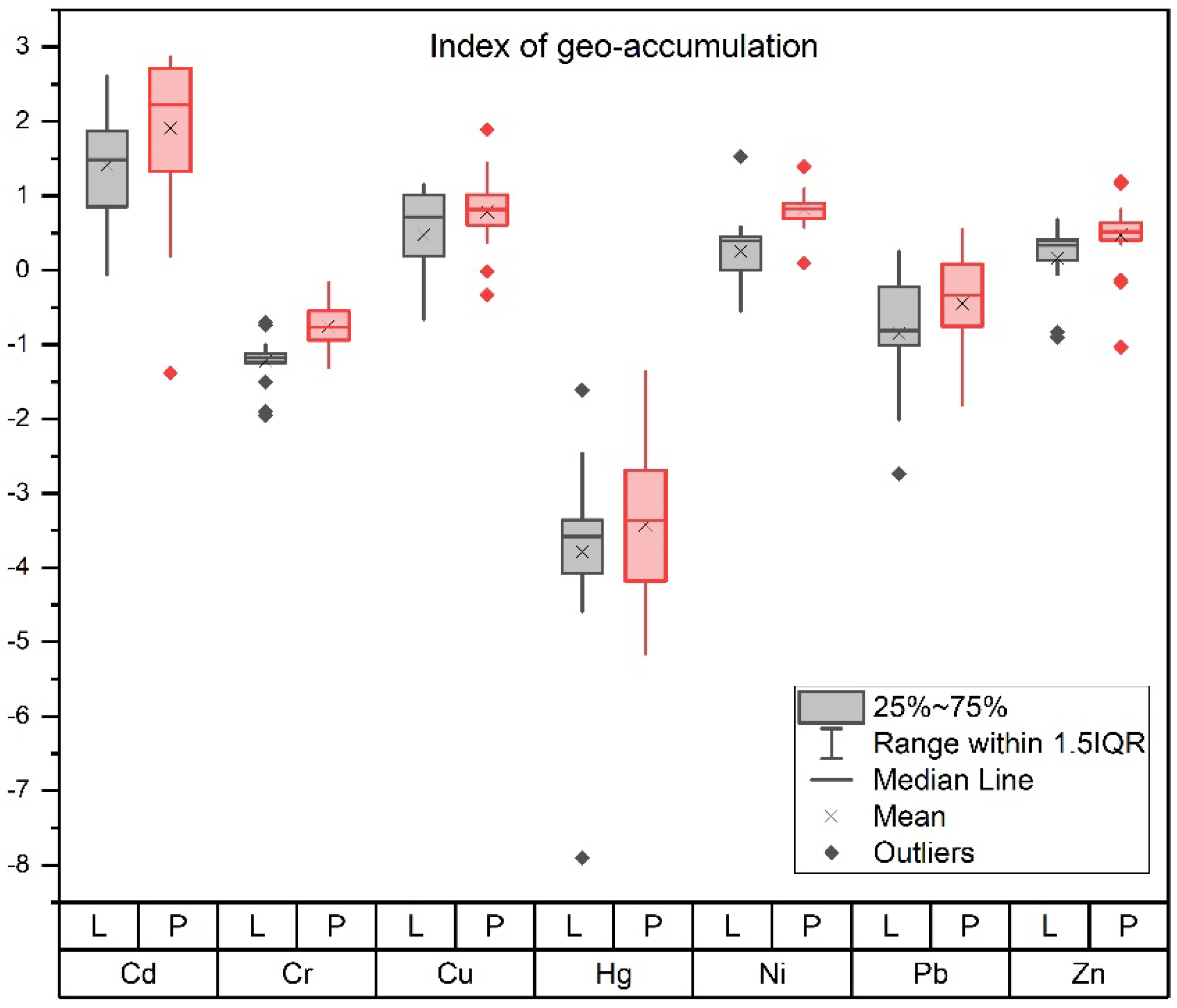
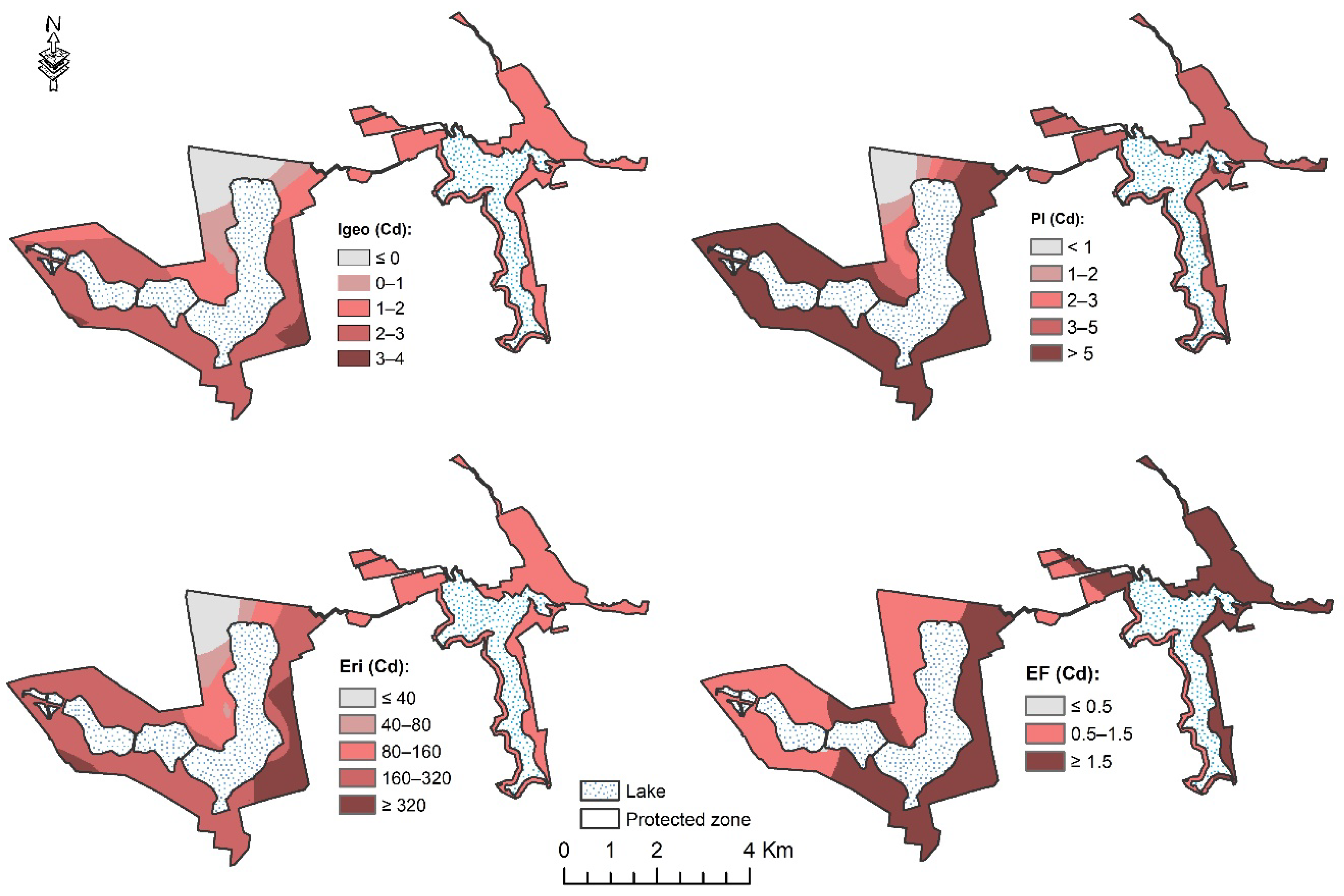
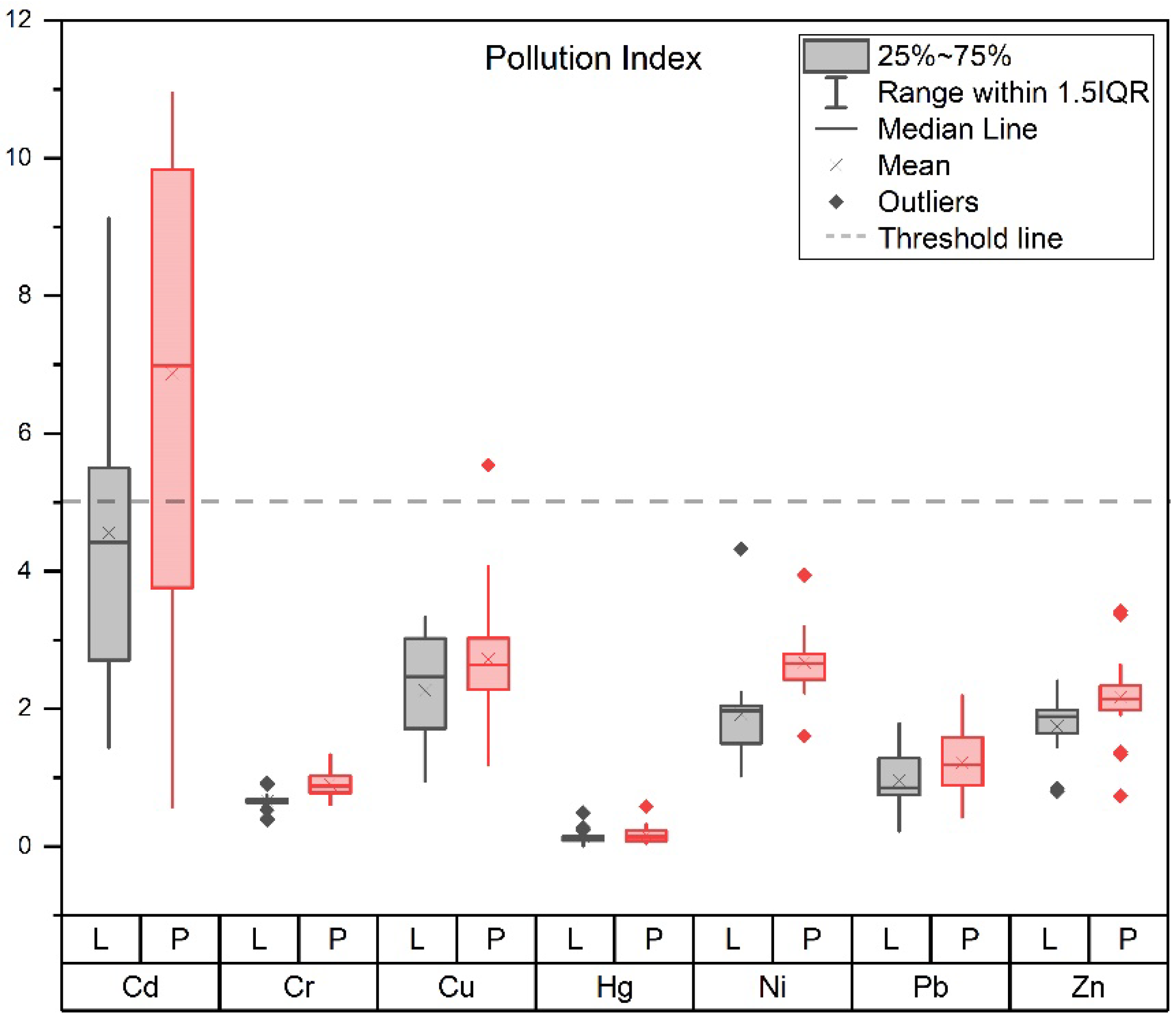

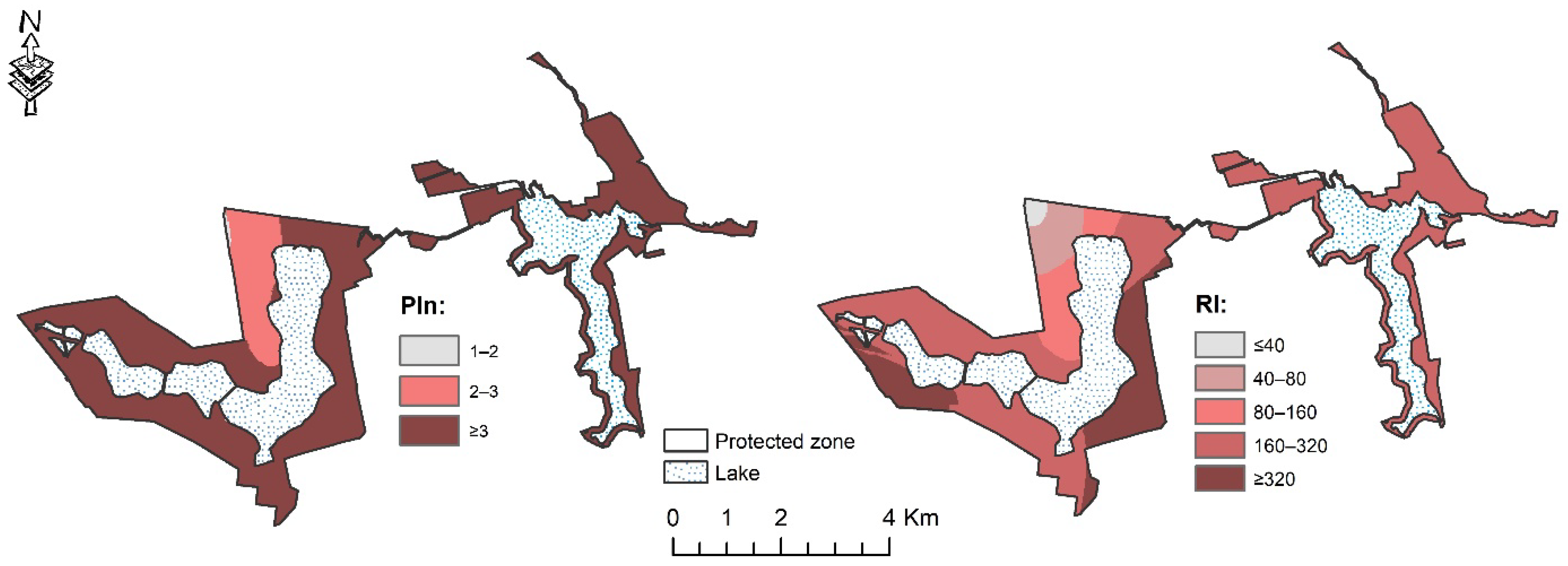
| Palić | Ludaš | |
|---|---|---|
| Area of water body | 579.77 ha | 328.5 ha |
| Length of shoreline | 28.08 km | 19.2 km |
| Buffer area (existing) | 15.1 ha | 5.7 ha |
| Buffer area (planned) | 13.6 ha | 17.3 ha |
| Soil type [41] | Calcic Chernozem; Arenic Chernozem | Solonchak; Histosol |
| Geomorphology | Loess; sand | |
| Climate | Temperate climate | |
| Precipitation | 568.3 mm | |
| Primary Macronutrients | Limit Values | Reference |
|---|---|---|
| N (%) | >0.3: high rich content 0.2–0.3: very rich content 0.1–0.2: rich content 0.06–0.1: moderately rich content 0.03–0.06: poor content 0.02–0.03: very poor content <0.02: limited ability to grow plants | [58,59] |
| P2O5 (mg/100 g) | <10.0: very low content 10.0–15.0: low content 15.0–20.0: middle content >25.0: high content | |
| K2O (mg/100 g) | >8.0: low content 8.0–12.0: middle content >12.0: high content |
| Index | Formula | Explanations | Limit Values | Reference |
|---|---|---|---|---|
| Enrichment factor | —concentration ratio of the examined metal and the reference element in soil samples —natural background value of the examined metal to the reference element ratio | 0.5 ≤ EF ≤ 1.5: taken as an indication that trace metal is entirely provided from crustal contribution EF > 1.5: an important proportion of trace metals is delivered from noncrustal materials | [69,70] | |
| Index of geoaccumulation | Cn—current heavy-metal content in topsoil; Bn—heavy-metal content in the NHs, bedrock, or geochemical background; 1.5—constant, allowing for analysis of fluctuations of heavy-metal content | ≤0: unpolluted 0–1: unpolluted to moderately polluted 1–2: moderately polluted 2–3: moderately to highly polluted 3–4: highly polluted 4–5: highly to extremely highly polluted ≥5: extremely highly polluted | [66] | |
| Pollution index | Cn—heavy-metal content in soil GB—values of geochemical background | <1: absent 1–2: low 2–3: moderate 3–5: strong >5: very strong | [67] | |
| Nemerow pollution index | PI—single pollution index of particular heavy metal —maximal value of single pollution index of all heavy metals n—number of studied heavy metals | ≤0.7: clean 0.7–1: warning limit 1–2: slight pollution 2–3: moderate pollution ≥3: heavy pollution | [68] | |
| Potential ecological risk index | —single index of ecological risk factor n—number of studied heavy metals — toxicity response coefficient of heavy metals PI—single pollution index of heavy metal | ≤ 40: low risk 40 ≤ < 80: moderate risk 80 ≤ < 160: considerable risk 160 ≤ < 320: great risk ≥320: very great risk RI < 65: low risk 65 < RI < 130: moderate risk 130 < RI < 260: considerable risk RI > 260: very high risk | [67,71] |
| Chemical Characteristics of Soil | Depth | Ludaš | Palić |
|---|---|---|---|
| pH (H2O) | 0–30 | 8.71 ± 0.33 | 8.41 ± 0.48 |
| 30–60 | 9.01 ± 0.36 | 8.68 ± 0.62 | |
| Humus (%) | 0–30 | 3.51 ± 1.13 | 3.94 ± 1.18 |
| 30–60 | 2.62 ± 0.49 | 3.08 ± 1.22 | |
| N (%) | 0–30 | 0.12 ± 0.06 | 0.11 ± 0.07 |
| 30–60 | 0.09 ± 0.07 | 0.08 ± 0.05 | |
| P2O5 mg/100 g | 0–30 | 62.09 ± 57.24 | 37.93 ± 27.56 |
| 30–60 | 65.04 ± 68.39 | 24.89 ± 19.91 | |
| K2O mg/100 g | 0–30 | 49.97 ± 25.01 | 37.49 ± 24.02 |
| 30–60 | 39.55 ± 24.29 | 24.83 ± 20.31 | |
| EC (µS/cm) | 0–30 | 181.12 ± 66.48 | 253.19 ± 430.35 |
| 30–60 | 260.00 ± 142.92 | 278.17 ± 347.76 | |
| Salt concentration (mg/L) | 0–30 | 91.05 ± 32.87 | 126.60 ± 215.17 |
| 30–60 | 130.35 ± 71.19 | 139.28 ± 173.91 |
| Zn | Cu | Pb | Cr | Ni | Mn | Cd | Hg | ||||||||||
|---|---|---|---|---|---|---|---|---|---|---|---|---|---|---|---|---|---|
| L | P | L | P | L | P | L | P | L | P | L | P | L | P | L | P | ||
| 0–30 | Mean | 36.13 | 40.86 | 9.67 | 11.15 | 7.63 | 8.63 | 10.10 | 13.17 | 14.26 | 17.13 | 314.52 | 435.77 | 0.59 | 1.00 | 0.02 | 0.03 |
| SD | 11.34 | 12.95 | 3.58 | 4.61 | 4.32 | 3.71 | 3.08 | 2.38 | 6.43 | 2.46 | 92.72 | 83.20 | 0.31 | 0.44 | 0.02 | 0.02 | |
| t-test | 0.13 | 0.15 | 0.34 | 0.00 ** | 0.03 * | 0.00 ** | 0.00 ** | 0.01 * | |||||||||
| 30–60 | Mean | 31.93 | 40.88 | 8.68 | 9.97 | 5.93 | 7.98 | 8.42 | 12.11 | 11.59 | 17.45 | 277.62 | 384.44 | 0.62 | 0.89 | 0.02 | 0.02 |
| SD | 10.15 | 11.83 | 3.28 | 3.15 | 2.43 | 4.38 | 1.93 | 2.86 | 3.05 | 3.43 | 79.74 | 81.55 | 0.31 | 0.42 | 0.01 | 0.02 | |
| t-test | 0.04 * | 0.28 | 0.14 | 0.00 ** | 0.00 ** | 0.00 ** | 0.06 | 0.98 | |||||||||
| Zn | Cu | Pb | Cr | Ni | Mn | Cd | Hg | pH | Humus | N | P2O5 | K2O | CaCO3 | EC | Clay | |
|---|---|---|---|---|---|---|---|---|---|---|---|---|---|---|---|---|
| Zn | 1 | |||||||||||||||
| Cu | 0.63 ** | 1 | ||||||||||||||
| Pb | 0.45 * | 0.53 * | 1 | |||||||||||||
| Cr | 0.58 ** | 0.50 * | 0.48 * | 1 | ||||||||||||
| Ni | 0.52 * | 0.37 | 0.56 ** | 0.85 ** | 1 | |||||||||||
| Mn | 0.42 | 0.40 | 0.48 * | 0.89 ** | 0.83 ** | 1 | ||||||||||
| Cd | −0.23 | −0.04 | −0.18 | −0.45 * | −0.36 | −0.47 * | 1 | |||||||||
| Hg | 0.40 | 0.78 ** | 0.11 | 0.36 | 0.14 | 0.25 | 0.17 | 1 | ||||||||
| pH | −0.26 | −0.47 * | −0.37 | −0.37 | −0.51 * | −0.43 * | −0.26 | −0.34 | 1 | |||||||
| Humus | 0.57 ** | 0.66 ** | 0.70 ** | 0.66 ** | 0.72 ** | 0.57 ** | 0.05 | 0.46 * | −0.64 ** | 1 | ||||||
| N | 0.24 | 0.60 * | 0.38 | 0.19 | 0.10 | 0.20 | 0.29 | 0.71 ** | −0.53 * | 0.56 ** | 1 | |||||
| P2O5 | 0.22 | 0.36 | 0.06 | 0.51 * | 0.23 | 0.33 | −0.01 | 0.34 | −0.13 | 0.35 | 0.04 | 1 | ||||
| K2O | 0.49 * | 0.33 | 0.43 * | 0.56 ** | 0.56 ** | 0.42 | −0.22 | 0.21 | −0.14 | 0.58 ** | −0.03 | 0.37 | 1 | |||
| CaCO3 | 0.00 | −0.32 | −0.19 | −0.36 | −0.05 | −0.48 * | 0.18 | −0.29 | 0.24 | −0.09 | −0.37 | −0.45 * | 0.17 | 1 | ||
| EC | −0.15 | −0.26 | −0.22 | −0.23 | −0.47 * | −0.32 | −0.35 | −0.16 | 0.94 ** | −0.51 * | −0.37 | −0.07 | −0.08 | 0.07 | 1 | |
| Clay | 0.39 | 0.08 | 0.26 | 0.68 ** | 0.79 ** | 0.62 ** | −0.27 | 0.06 | −0.29 | 0.54 * | 0.01 | 0.09 | 0.45 * | 0.17 | −0.30 | 1 |
| Zn | Cu | Pb | Cr | Ni | Mn | Cd | Hg | pH | Humus | N | P2O5 | K2O | CaCO3 | EC | Clay | |
|---|---|---|---|---|---|---|---|---|---|---|---|---|---|---|---|---|
| Zn | 1 | |||||||||||||||
| Cu | 0.69 ** | 1 | ||||||||||||||
| Pb | 0.62 * | 0.85 ** | 1 | |||||||||||||
| Cr | 0.79 ** | 0.65 * | 0.41 | 1 | ||||||||||||
| Ni | 0.31 | 0.69 ** | 0.49 | 0.71 ** | 1 | |||||||||||
| Mn | 0.45 | 0.65 * | 0.49 | 0.39 | 0.31 | 1 | ||||||||||
| Cd | 0.35 | −0.07 | 0.22 | 0.27 | −0.06 | −0.06 | 1 | |||||||||
| Hg | 0.27 | −0.37 | −0.50 | 0.26 | −0.34 | −0.37 | 0.27 | 1 | ||||||||
| pH | −0.14 | 0.13 | 0.26 | −0.19 | 0.14 | 0.18 | −0.15 | −0.55 | 1 | |||||||
| Humus | 0.72 ** | 0.66 * | 0.50 | 0.74 ** | 0.58 * | 0.19 | 0.07 | 0.19 | 0.07 | 1 | ||||||
| N | −0.26 | −0.39 | −0.46 | 0.12 | 0.16 | −0.72 ** | 0.13 | 0.39 | −0.15 | 0.04 | 1 | |||||
| P2O5 | 0.40 | 0.56 * | 0.64 * | 0.12 | 0.07 | 0.26 | 0.01 | −0.25 | −0.28 | 0.03 | −0.42 | 1 | ||||
| K2O | 0.39 | 0.72 ** | 0.52 | 0.55 | 0.67 * | 0.40 | −0.26 | −0.21 | −0.06 | 0.40 | −0.20 | 0.56 * | 1 | |||
| CaCO3 | −0.07 | 0.31 | 0.44 | −0.06 | 0.37 | 0.08 | −0.05 | −0.46 | 0.45 | 0.36 | −0.12 | −0.12 | 0.03 | 1 | ||
| EC | 0.23 | 0.64 * | 0.60 * | 0.34 | 0.69 ** | 0.43 | −0.18 | −0.53 | 0.73 ** | 0.51 | −0.22 | −0.03 | 0.51 | 0.62 * | 1 | |
| Clay | 0.21 | 0.37 | 0.39 | 0.03 | 0.08 | 0.78 ** | 0.03 | −0.45 | 0.56 * | 0.08 | −0.69 ** | −0.09 | 0.01 | 0.33 | 0.52 | 1 |
Publisher’s Note: MDPI stays neutral with regard to jurisdictional claims in published maps and institutional affiliations. |
© 2021 by the authors. Licensee MDPI, Basel, Switzerland. This article is an open access article distributed under the terms and conditions of the Creative Commons Attribution (CC BY) license (https://creativecommons.org/licenses/by/4.0/).
Share and Cite
Caković, M.; Beloica, J.; Belanović Simić, S.; Miljković, P.; Lukić, S.; Baumgertel, A.; Schwaiger, F. Diffuse Pollution and Ecological Risk Assessment in Ludaš Lake Special Nature Reserve and Palić Nature Park (Pannonian Basin). Forests 2021, 12, 1461. https://doi.org/10.3390/f12111461
Caković M, Beloica J, Belanović Simić S, Miljković P, Lukić S, Baumgertel A, Schwaiger F. Diffuse Pollution and Ecological Risk Assessment in Ludaš Lake Special Nature Reserve and Palić Nature Park (Pannonian Basin). Forests. 2021; 12(11):1461. https://doi.org/10.3390/f12111461
Chicago/Turabian StyleCaković, Milica, Jelena Beloica, Snežana Belanović Simić, Predrag Miljković, Sara Lukić, Aleksandar Baumgertel, and Fritz Schwaiger. 2021. "Diffuse Pollution and Ecological Risk Assessment in Ludaš Lake Special Nature Reserve and Palić Nature Park (Pannonian Basin)" Forests 12, no. 11: 1461. https://doi.org/10.3390/f12111461
APA StyleCaković, M., Beloica, J., Belanović Simić, S., Miljković, P., Lukić, S., Baumgertel, A., & Schwaiger, F. (2021). Diffuse Pollution and Ecological Risk Assessment in Ludaš Lake Special Nature Reserve and Palić Nature Park (Pannonian Basin). Forests, 12(11), 1461. https://doi.org/10.3390/f12111461








